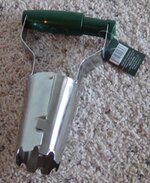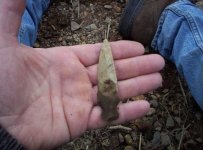madfranks
Full Member
- May 15, 2006
- 167
- 4
- Detector(s) used
- Tesoro Vaquero
I saw this product designed to easily cut a 2.5" hole up to nine inches deep, for digging around grassy areas. What do you guys think about it, and has anyone used one before?
http://www.famoustreasures.com/?main_page=product_info&products_id=47
http://www.famoustreasures.com/?main_page=product_info&products_id=47



 Not sure of the shape, where they can piece geometric plugs together to cover larger areas. From what I read, the key is to make sure you cut deep enough and leave enough soil under the sod. I am not sure if it has to do with cutting a complete circle as it does stripping the sod too shallowly off the ground. I would always, even if the target on my detector is 2" take a full plug out. Although, if your target is that shallow, like I mentioned above, you would be better just cutting a slit in the ground and probing for the target. You shouldn't take a shallow plug, just like you want to be careful to not cut your flaps too close to the surface also. You should plan to only take a full plug. That would be 4 or 5" deep with all the soil attached. If you find the target, remove it carefully. Don't uneccesarily crumble all the dirt away from your plug. That is where the roots are and if you cut too shallow or overwork all the soil away from the grass, you will damage those roots. It is better to drop a 5" thick plug back in the ground, rather than one that is only an inch or two. When you do replace your plug, make sure to tamp it or press it down good to make sure the roots get good contact with the soil that surrounds the plug. It can take longer for the roots to recover if they don't have adequate dirt under or around them. Soil left also retains moisture and protects the roots from the heat and drying of the sun. I really believe that is the source of most of the problems. Another thing that one should condiser doing, whether cutting a 3 sided flap or a plug. If it is dry and there is not any rain in the forcast, don't dig. Or if you must, carry a bottle of water around with you so you can water your plugs in. Also, avoid plugging in the middle of the afternoon or on hot dry sunny days. I think it was discussed one time before, Take a bottle of Cayanne Pepper with you also. Sprinkle it over and under the plug to deter animals from digging up your flaps and plugs.
Not sure of the shape, where they can piece geometric plugs together to cover larger areas. From what I read, the key is to make sure you cut deep enough and leave enough soil under the sod. I am not sure if it has to do with cutting a complete circle as it does stripping the sod too shallowly off the ground. I would always, even if the target on my detector is 2" take a full plug out. Although, if your target is that shallow, like I mentioned above, you would be better just cutting a slit in the ground and probing for the target. You shouldn't take a shallow plug, just like you want to be careful to not cut your flaps too close to the surface also. You should plan to only take a full plug. That would be 4 or 5" deep with all the soil attached. If you find the target, remove it carefully. Don't uneccesarily crumble all the dirt away from your plug. That is where the roots are and if you cut too shallow or overwork all the soil away from the grass, you will damage those roots. It is better to drop a 5" thick plug back in the ground, rather than one that is only an inch or two. When you do replace your plug, make sure to tamp it or press it down good to make sure the roots get good contact with the soil that surrounds the plug. It can take longer for the roots to recover if they don't have adequate dirt under or around them. Soil left also retains moisture and protects the roots from the heat and drying of the sun. I really believe that is the source of most of the problems. Another thing that one should condiser doing, whether cutting a 3 sided flap or a plug. If it is dry and there is not any rain in the forcast, don't dig. Or if you must, carry a bottle of water around with you so you can water your plugs in. Also, avoid plugging in the middle of the afternoon or on hot dry sunny days. I think it was discussed one time before, Take a bottle of Cayanne Pepper with you also. Sprinkle it over and under the plug to deter animals from digging up your flaps and plugs. 

